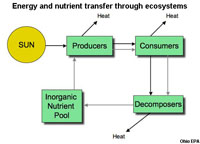13.9: Factors Influencing Primary Production
- Page ID
- 10358
Factors influencing Primary Production
Sunlight and Nutrient Availability
Sunlight penetration decrease with depth; it is impacted by water clarity (turbidity).
The Epipelagic Zone is also called the Euphotic Zone (where sunlight penetrates, Figure 13.19).
The Euphotic zone extends downward around 200 meters in the open ocean, but varies with seasonal changes in turbidity. This zone is also called the neritic zone on continental shelves and the epipelagic zone in open ocean settings. The euphotic zone where all photosynthesis takes place. It is also the part of the ocean most likely to have a thermocline is mostly above the oxygen minimal zone (OMZ).

Compensation Depth: where respiration (consumption) equals photosynthesis production. The compensation depth is depth at which the light intensity is just sufficient to balance between the amount of oxygen produced and consumed by algae (typically a depth where only 0.1-1% of solar radiation penetrates). The compensation depth varies with latitude, water clarity, and nutrient availability.
Nutrients: These are not like food, they are more like a fertilizer. Major nutrients in need for biological activity include nitrogen, phosphorus, and silicon, iron, zinc, and copper. Organic compounds including vitamins are also essential. However, some nutrients can become toxic if concentrations become too high.
Sources of nutrients include:
* Upwelling from deep ocean (particularly nitrates and phosphates)
* Rock weathering (minerals provide iron, silica, and other element)
* Decaying organic matter (releases elements and vitamins back into seawater)
Human activities are also creating artificial sources of nutrients: Agriculture (fertilizers) and pollution (sewers, etc.)
 |
 |
| Figure 13.20. Energy and nutrient transfer through ecosystems. | Figure 13.21. Sources of ocean pollution. |
Measuring Primary Productivity
Primary Productivity is measured in biomass or in gC/m2 day (or grams of carbon per square meter per day). Ocean biomass is measured by pulling fine nets to catch plankton and weighing/examining catch (however, smallest organisms pass through nets). Ocean biomass is also measured by satellite: 2 dimensions (i.e.: square meters per day). Satellites can detect levels of chlorophyll in seawater, but not far below the surface.
Question: How could this be a source of error in measuring biomass?


